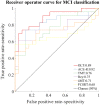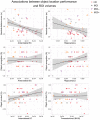Assessing mild cognitive impairment using object-location memory in immersive virtual environments
- PMID: 35916343
- PMCID: PMC9543035
- DOI: 10.1002/hipo.23458
Assessing mild cognitive impairment using object-location memory in immersive virtual environments
Abstract
Pathological changes in the medial temporal lobe (MTL) are found in the early stages of Alzheimer's disease (AD) and aging. The earliest pathological accumulation of tau colocalizes with the areas of the MTL involved in object processing as part of a wider anterolateral network. Here, we sought to assess the diagnostic potential of memory for object locations in iVR environments in individuals at high risk of AD dementia (amnestic mild cognitive impairment [aMCI] n = 23) as compared to age-related cognitive decline. Consistent with our primary hypothesis that early AD would be associated with impaired object location, aMCI patients exhibited impaired spatial feature binding. Compared to both older (n = 24) and younger (n = 53) controls, aMCI patients, recalled object locations with significantly less accuracy (p < .001), with a trend toward an impaired identification of the object's correct context (p = .05). Importantly, these findings were not explained by deficits in object recognition (p = .6). These deficits differentiated aMCI from controls with greater accuracy (AUC = 0.89) than the standard neuropsychological tests. Within the aMCI group, 16 had CSF biomarkers indicative of their likely AD status (MCI+ n = 9 vs. MCI- n = 7). MCI+ showed lower accuracy in the object-context association than MCI- (p = .03) suggesting a selective deficit in object-context binding postulated to be associated with anterior-temporal areas. MRI volumetric analysis across healthy older participants and aMCI revealed that test performance positively correlates with lateral entorhinal cortex volumes (p < .05) and hippocampus volumes (p < .01), consistent with their hypothesized role in binding contextual and spatial information with object identity. Our results indicate that tests relying on the anterolateral object processing stream, and in particular requiring successful binding of an object with spatial information, may aid detection of pre-dementia AD due to the underlying early spread of tau pathology.
Keywords: Alzheimer's disease; entorhinal cortex; spatial cognition; virtual reality.
© 2022 The Authors. Hippocampus published by Wiley Periodicals LLC.
Conflict of interest statement
The authors declare no conflict of interests.
Figures







Similar articles
-
Structural magnetic resonance imaging for the early diagnosis of dementia due to Alzheimer's disease in people with mild cognitive impairment.Cochrane Database Syst Rev. 2020 Mar 2;3(3):CD009628. doi: 10.1002/14651858.CD009628.pub2. Cochrane Database Syst Rev. 2020. PMID: 32119112 Free PMC article.
-
Lateral entorhinal cortex dysfunction in amnestic mild cognitive impairment.Neurobiol Aging. 2022 Apr;112:151-160. doi: 10.1016/j.neurobiolaging.2021.12.008. Epub 2021 Dec 30. Neurobiol Aging. 2022. PMID: 35182842 Free PMC article.
-
T2 Relaxometry and Diffusion Tensor Indices of the Hippocampus and Entorhinal Cortex Improve Sensitivity and Specificity of MRI to Detect Amnestic Mild Cognitive Impairment and Alzheimer's Disease Dementia.J Magn Reson Imaging. 2019 Feb;49(2):445-455. doi: 10.1002/jmri.26195. Epub 2018 Sep 13. J Magn Reson Imaging. 2019. PMID: 30209854 Free PMC article.
-
Structural Alteration of Medial Temporal Lobe Subfield in the Amnestic Mild Cognitive Impairment Stage of Alzheimer's Disease.Neural Plast. 2022 Jan 24;2022:8461235. doi: 10.1155/2022/8461235. eCollection 2022. Neural Plast. 2022. PMID: 35111220 Free PMC article.
-
Neuropathologic alterations in mild cognitive impairment: a review.J Alzheimers Dis. 2010;19(1):221-8. doi: 10.3233/JAD-2010-1220. J Alzheimers Dis. 2010. PMID: 20061641 Free PMC article. Review.
Cited by
-
Early Spatio-Temporal and Cognitive Deficits in Alzheimer's Disease.J Clin Med. 2025 Jan 17;14(2):579. doi: 10.3390/jcm14020579. J Clin Med. 2025. PMID: 39860585 Free PMC article.
-
RADAR-AD: assessment of multiple remote monitoring technologies for early detection of Alzheimer's disease.Alzheimers Res Ther. 2025 Jan 27;17(1):29. doi: 10.1186/s13195-025-01675-0. Alzheimers Res Ther. 2025. PMID: 39865315 Free PMC article.
-
Virtual Reality and Serious Videogame-Based Instruments for Assessing Spatial Navigation in Alzheimer's Disease: A Systematic Review of Psychometric Properties.Neuropsychol Rev. 2025 Mar;35(1):77-101. doi: 10.1007/s11065-024-09633-7. Epub 2024 Feb 26. Neuropsychol Rev. 2025. PMID: 38403731 Free PMC article.
-
Integrating Biomarkers From Virtual Reality and Magnetic Resonance Imaging for the Early Detection of Mild Cognitive Impairment Using a Multimodal Learning Approach: Validation Study.J Med Internet Res. 2024 Apr 17;26:e54538. doi: 10.2196/54538. J Med Internet Res. 2024. PMID: 38631021 Free PMC article.
-
Digital Ergonomics of NavegApp, a Novel Serious Game for Spatial Cognition Assessment: Content Validity and Usability Study.JMIR Serious Games. 2025 Apr 2;13:e66167. doi: 10.2196/66167. JMIR Serious Games. 2025. PMID: 40173437 Free PMC article.
References
Publication types
MeSH terms
Grants and funding
LinkOut - more resources
Full Text Sources
Medical

